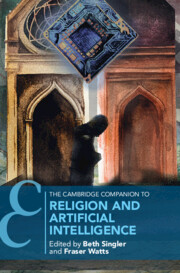Book contents
- The Cambridge Companion to Religion and Artificial Intelligence
- Cambridge Companions to Religion
- The Cambridge Companion to Religion and Artificial Intelligence
- Copyright page
- Contents
- Contributors
- Acknowledgements
- 1 Introduction
- 2 Steps towards Android Intelligence
- Part I Religions and AI
- 3 Hinduism and Artificial Intelligence
- 4 The Buddha in AI/Robotics
- 5 Artificial Intelligence and Jewish Thought
- 6 Artificial Intelligence and Christianity
- 7 Islam and Artificial Intelligence
- Part II Social and Moral Issues
- Part III Religious Studies
- Bibliography
- Index
- Cambridge Companions to Religion (continued from page ii)
- References
3 - Hinduism and Artificial Intelligence
from Part I - Religions and AI
Published online by Cambridge University Press: 20 November 2024
- The Cambridge Companion to Religion and Artificial Intelligence
- Cambridge Companions to Religion
- The Cambridge Companion to Religion and Artificial Intelligence
- Copyright page
- Contents
- Contributors
- Acknowledgements
- 1 Introduction
- 2 Steps towards Android Intelligence
- Part I Religions and AI
- 3 Hinduism and Artificial Intelligence
- 4 The Buddha in AI/Robotics
- 5 Artificial Intelligence and Jewish Thought
- 6 Artificial Intelligence and Christianity
- 7 Islam and Artificial Intelligence
- Part II Social and Moral Issues
- Part III Religious Studies
- Bibliography
- Index
- Cambridge Companions to Religion (continued from page ii)
- References
Summary
This chapter explores the intersection of Hindu philosophy and practice with the development of artificial intelligence (AI). The chapter first introduces aspects of technological growth in Hindu contexts, including the reception of ‘Western’ ideas about AI in Hindu communities before describing key elements of the Hindu traditions. It then shows how AI technologies can be conceived of from a Hindu perspective and moves from there to the philosophical contributions Hinduism offers for global reflection on AI. Specifically, the chapter describes openings and contentions for AI in Hindu rituals. The focus is the use of robotics and/or AI in Hindu pūjā (worship of gods) and the key practice of darśan (mutual seeing) with the divine. Subsequently, the chapter investigates how Hindu philosophers have engaged the distinctive qualities of human beings and their investigation into body, minds and consciousness/awareness. The chapter concludes by raising questions for future research.
- Type
- Chapter
- Information
- Publisher: Cambridge University PressPrint publication year: 2024

